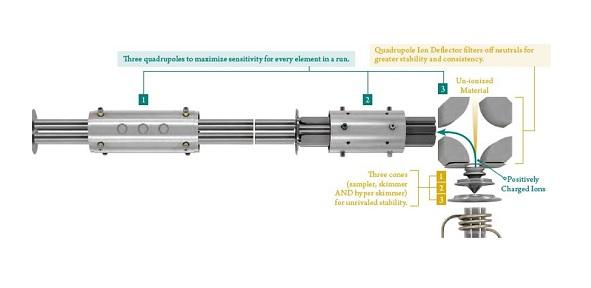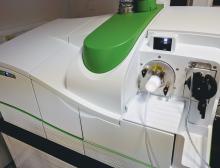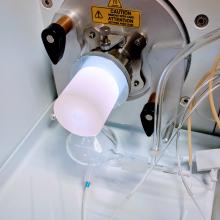
Trace element analysis for aqueous solutions, or solid sample analysis by laser ablation.
Introduction
 Our instrument is a Perkin Elmer Nexion 350D quadrupole-based Inductively Coupled Plasma - Mass Spectrometer (ICP-MS). Detection limits in liquid solution for many elements are better than 1 ppt (ng/L) while analytical precision is typically 0.5 - 5% RSD at one standard deviation. The instrument is also fitted with a Collision/Reaction cell for the removal of many ICP-MS interferences. that is capable of rapidly analyzing up to seventy elements in a wide range of samples, both aqueous (solution mode) and solids (laser ablation).
Our instrument is a Perkin Elmer Nexion 350D quadrupole-based Inductively Coupled Plasma - Mass Spectrometer (ICP-MS). Detection limits in liquid solution for many elements are better than 1 ppt (ng/L) while analytical precision is typically 0.5 - 5% RSD at one standard deviation. The instrument is also fitted with a Collision/Reaction cell for the removal of many ICP-MS interferences. that is capable of rapidly analyzing up to seventy elements in a wide range of samples, both aqueous (solution mode) and solids (laser ablation).
To encourage collaboration in the Department, University, and elsewhere we offer limited access to our ICP-MS instrument for scientific research purposes. We have excellent laboratory facilities for sample and standard preparation of geochemical samples, and various established sample preparation procedures.
ICP-MS details
 In standard solution mode, aqueous liquid samples are introduced by an adjustable peristaltic pump. A nebuliser generates an aerosol in a spray chamber that allows fine aerosol droplets to pass to a high power argon plasma which rapidly desolvates, atomises, and ionises the sample creating a beam of singly charged positive ions.
In standard solution mode, aqueous liquid samples are introduced by an adjustable peristaltic pump. A nebuliser generates an aerosol in a spray chamber that allows fine aerosol droplets to pass to a high power argon plasma which rapidly desolvates, atomises, and ionises the sample creating a beam of singly charged positive ions.
These ions are rapidly accelerated into the vacuum of a mass spectromer via a triple cone system involving sampler, skimmer, and hyper skimmer cones. Ion focusing is achieved by a Quadrupole Ion Deflector, followed by mass filtering in a quadrupole. The ions are sequentially detected in a single channel electron multiplier.
In cell gas mode, a gas (such as helium, ammonia, etc.) is introduced to a pressurised collision/reaction cell prior to the analytical quadrupole. In this collision/reaction cell, fast gas-phase kinetic energy processes and predictable chemical reactions take place. Many common ICP-MS interferences are removed from the ion beam while the analyte ions are allowed to pass through to the detector.
The ion beam pathway is shown above.
Normal ICP-MS Mode
No cell gas is used and the instrument works as a non-cell instrument, a mode for elements not requiring interference correction and often used for Laser Ablation.
Collision (He) Mode
A non-reactive gas is introduced into the Universal Cell cell to collide with interfering ions with larger diameters, affecting their kinetic energy to be removed through Kinetic Energy Discrimination.
Reaction Mode
A highly reactive gas such as Ammonia is introduced into the cell to create predictable chemical reactions with interferences or analyte ions (oxide mass shifting). The interferences or side reactions are removed by a scanning quadrupole so only the mass of interest is passed to the quadrupole and detector.
Contact information
To use the ICP-MS facility or discuss potential collaborative research projects, please contact the following:
Dr Sally A. Gibson
Telephone: +44 (0)1223 333401
Dr Jason A. Day
Telephone: +44 (0)1223 765 282
University of Cambridge
Department of Earth Sciences
Downing Street
Cambridge
CB2 3EQ
